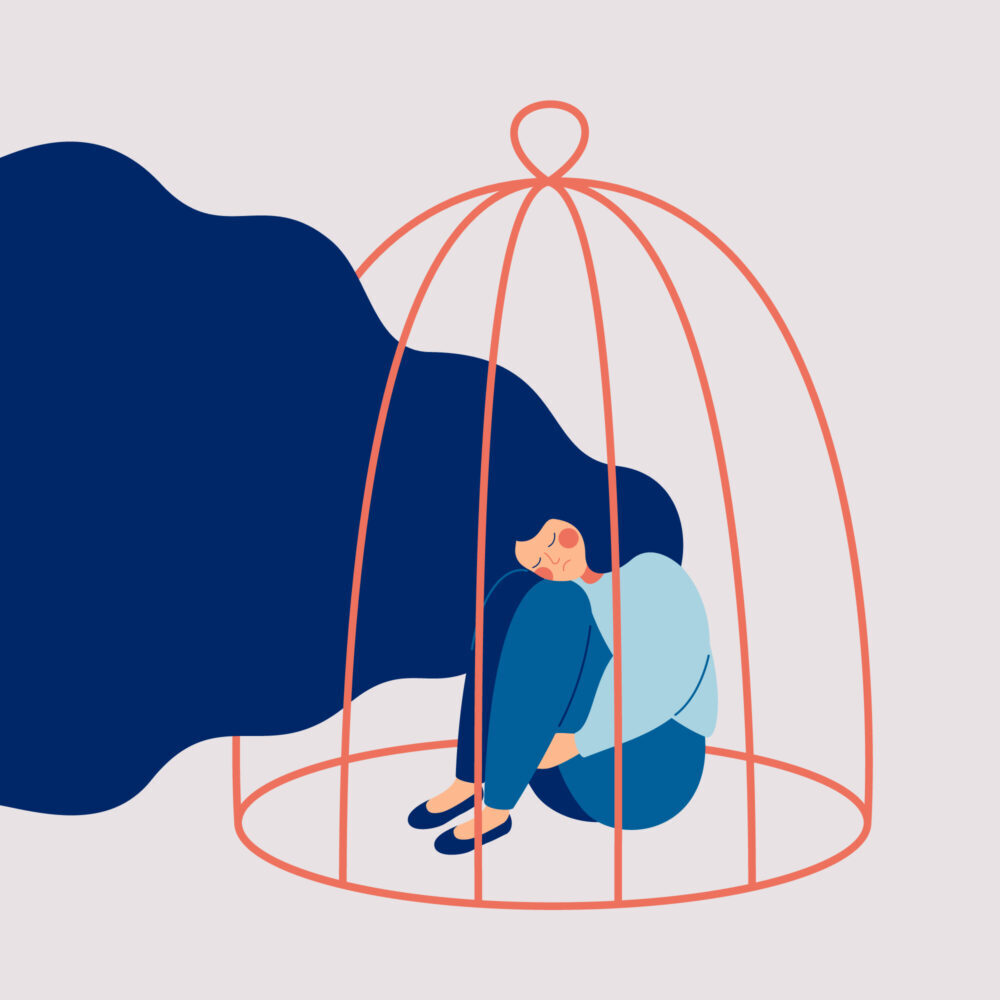The following article is a condensed version of a research paper delivered at the ANU Gender Institute symposium on ‘Understanding Coercive Control’ that explored coercive control from multiple inter-disciplinary perspectives.
The issue of coercive control – what is it, how do we recognise it, should it be criminalised – has been subjected to significant media and public attention in the last few years. This, in conjunction with the fact that the term ‘coercive control’ was only coined in 2007 by sociologist Evan Stark, contributes to the assumption that coercive control is a new phenomenon.
However, the patterns of behaviours designed to intimate, control, and isolate an individual that Stark classifies as coercive control have been a feature of intimate partnerships since at least the nineteenth century.
Notably, it was as early as the 1880s that these behaviours were beginning to be criticised and recognised as unacceptable masculine marital behaviours, or as abuses of patriarchal authority. Through law and literature, wives and women were claiming that a husband’s unquestioned control over all aspects of his wife’s life was an unacceptable abuse of patriarchal power – with some divorce court judges supporting this assertion.
The 1886 novel of Rosa Praed, The Right Honourable, is an enlightening example of how colonial women used literature to critique domestic violence in all its forms, including the non-physical and especially patterns of behaviour that would now be termed coercive control. Despite Praed being Australia’s most popular and well-known female author during the late nineteenth and early twentieth centuries, renowned for her damning portrayals and critiques of marriage, few of her books have been reprinted since their original publication.
The Right Honourable is no exception to this – despite being reprinted multiple times throughout the 1880s and 1890s, it has been out of print for a century.

Zoe Smith believes the 1886 novel of Rosa Praed, The Right Honourable, is an enlightening example of how colonial women used literature to critique domestic violence in all its forms. Picture: Supplied
In The Right Honourable, Crichton Kenway is introduced as a man ‘who seemed fairly fitted to be a hero of romance of the conventional order. He was tall, upright, good-looking, well dressed, and had an air of breeding’. A politician who moves in all the right social circles, he and his Australian wife Koorali seemingly have the perfect relationship. However, Crichton’s marital behaviour means that the marriage between himself and Koorali is clearly no ‘romance of the conventional order’.
The marriage is characterised by psychological and verbal abuse directed towards Koorali, with Crichton’s behaviour comprehensible to the modern reader as behaviour we would now term ‘coercive control’ and ‘gaslighting’.
Crichton tells Koorali how to dress, he regulates her behaviour at balls to ensure she is constantly working to his advantage in using her feminine wiles to charm his superiors, he reads her letters over her shoulder, he criticises and monitors her expenditure. All this occurs in conjuction with his verbal abuse designed to belittle and demean her, ‘crude, hard things in a way that hurt her like a blow’.
As Praed describes, ‘Crichton, though never absolutely rude or rough, had a rasping, overbearing manner at home – a way of harking upon mean detail, of fault-finding, and of attributing the lowest motive to every action, which often caused Koorali to wince, destroying her spontaneity and self-confidence, and making her timid and reserved, and less and less a thing of flesh and blood’. Resultantly, Koorali ‘began to believe that she was really stupid and wanting in common sense, as Crichton so often told her, and that he had reasonable cause for complaint’.
Notably, these behaviours are the most prominent form of domestic violence depicted by Praed in the novel, and are judged by Praed and other characters in the text, both male and female, to be behaviours beyond reasonable patriarchal authority. It is insinuated that this form of abuse is inherently linked to other forms of domestic violence – later in the text when Koorali states that she will leave Crichton as a result of his controlling behaviour, he threatens her with legally sanctioned marital rape which is coupled with the first explicit hinting of an act of physical violence – ‘he made a gesture as if he would have fell upon her and throttled her there and then’.
The acts of verbal and psychological abuse, and what we would consider coercive control, are the key feature Praed sought to emphasise in her critique of masculine marital behaviour – her fiction, situated in the romance and domestic realist genres, generally sought to highlight the myriad forms of abuse faced by wives in colonial marriages.
These patterns of behaviours were not a new form of unacceptable marital masculine behaviour for colonial female authors such as Praed to criticise. From 1880, Ada Cambridge, a popular writer of serial fiction in Australian newspapers, detailed the systematic regime of control and abuse wives could suffer at the hands of husbands in her fiction. In Cambridge’s ‘Dinah’, serialised in The Australasian from 1879-1880, Dinah’s husband subjects her to a regime of humiliation, economic control, and psychological abuse that would be recognised today as coercive control: ‘he watched over her expenditure with a suspicious watchfulness that pounced upon every sixpence wasted; and if she tore her dress, or knocked over a wineglass, he made her life a burden to her for hours afterwards’.
As the narrator describes of Dinah’s experiences: ‘the humiliations to which she was subjected were petty, indeed, from an outside point of view – hints and slights and sneers that made no noise or scandal but they were nonetheless the cruellest that the ingenuity of an aggrieved husband, who was at once bully and coward, could devise’.
In a similar state of marital relations to Koorali and Crichton, the psychological abuse and controlling behaviour perpetrated by Dinah’s husband is the only instance of domestic violence that Cambridge explicitly details, aside from hinting at an occasion of marital rape.
By the mid 1880s then, there was certainly a growing awareness and criticism of the myriad of forms that domestic violence could take in marriages. The question of what to call this spectrum of behaviours was a difficult one – whilst ‘wife-beating’ was still the most popular term, connoting images of working class men perpetrating physical violence, courts and newspapers focused more broadly on what they termed ‘cruelty’, a legal term subjective to the discretion of individual judges. Acts that we would now consider to be economic violence, psychological abuse, and coercive control were either constructed as ‘mental cruelty’ or as constituting a broader ‘system of tyranny’ that a husband could subject his wife to.
By 1890, the New South Wales case of Hume v Hume, presided over by Justice Windeyer, court cemented ‘mental cruelty’ and a husband’s ‘system of tyranny’ as a form of domestic violence cruel enough to warrant a wife a divorce without also declaring physical violence. Edward Hume had ‘cut his wife Ellen off from the intercourse of her friends; refused to speak to her for days and weeks, except in orders’ coupled with oaths and abuse, and refused to let her leave their property’.
Yet, coercive control alone or accompanied by the ‘occasional’ blow was not enough to break the sacred bonds of marriage across the whole of Australia – Windeyer was the exception amongst his fellow judges in Victoria and Queensland. Dismissing a 1912 case in Queensland in which William Tredea had isolated his wife Laura on a rural pastoral station and controlled the amount of time she spent with her children, Justice Shand declared he had to be ‘careful not to go beyond the limits of legal cruelty’ and to not overly restrict a husband’s understood household authority.
A husband’s ‘system of tyranny’ could therefore and still was tolerated and upheld, despite growing awareness and criticism, and it wouldn’t be until the 1970s that this broader pattern of abusive behaviours would again be brought to public attention by feminists criticising domestic violence more broadly. The establishment of women’s refuges such as Elsie in 1974, alongside the testimonies of wives to the Royal Commission on Human Relationships published in 1977, put a spotlight on domestic violence, with acts of coercive control given renewed public and feminist attention. See Michelle Arrow’s The Seventies for more on this.
Yet, it has taken until 2007 for the pattern of behaviours to be given an official name and definition, and it is only in the last few years, in the wake of cases such as the murder of Hannah Clarke and the subsequent relevant of the nature of her husband’s abusive and controlling behaviour, that the impacts of such behaviours are beginning to be taken seriously.
Why has it taken this long for coercive control to be given this spotlight? That I can’t answer, but it is high time that we acknowledge that coercive control in Australia has been the subject of feminist and legal attention for 150 years.
As for what historians like myself can contribute to current discussions by historicising coercive control, openly acknowledging the cultural discourses and acceptability around contemporary forms of violence, and judging historical violence by current standards, allows for a revitalised and more complex understanding of domestic violence in the past – an understanding that is vital in thinking about domestic violence and coercive control in Australia and Australian society more broadly if we ever going to deal with our ‘national problem’.
Zoe Smith is a PhD candidate in the School of History at ANU. Her thesis is a feminist, social, and cultural history of domestic violence in Australia from 1880-1914.





